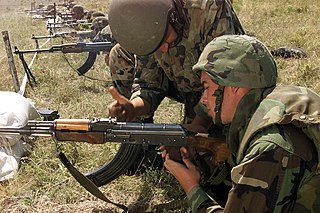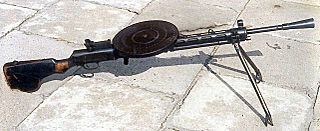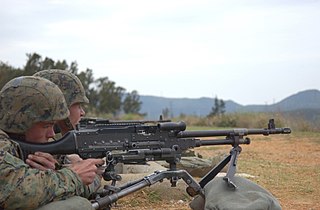
A squad automatic weapon (SAW), also known as a section automatic weapon or light support weapon (LSW), is a man-portable automatic firearm attached to infantry squads or sections as a source of rapid direct firepower. Weapons fulfilling this role can be light machine guns, or modified selective-fire rifles fitted with a heavier barrel, bipod and a belt/drum-fed design.

The Bren gun was a series of light machine guns (LMG) made by Britain in the 1930s and used in various roles until 1992. While best known for its role as the British and Commonwealth forces' primary infantry LMG in World War II, it was also used in the Korean War and saw service throughout the latter half of the 20th century, including the 1982 Falklands War. Although fitted with a bipod, it could also be mounted on a tripod or be vehicle-mounted.

The Chauchat was the standard light machine gun or "machine rifle" of the French Army during World War I (1914–18). Its official designation was "Fusil Mitrailleur Modele 1915 CSRG". Beginning in June 1916, it was placed into regular service with French infantry, where the troops called it the FM Chauchat, after Colonel Louis Chauchat, the main contributor to its design. The Chauchat in 8mm Lebel was also extensively used in 1917–18 by the American Expeditionary Forces (A.E.F.), where it was officially designated as the "Automatic Rifle, Model 1915 (Chauchat)". A total of 262,000 Chauchats were manufactured between December 1915 and November 1918, including 244,000 chambered for the 8mm Lebel service cartridge, making it the most widely manufactured automatic weapon of World War I. The armies of eight other nations—Belgium, Finland, Greece, Italy, Poland, Romania, Russia, and Serbia—also used the Chauchat machine rifle in fairly large numbers during and after World War I.

The Browning Automatic Rifle (BAR) is a family of American automatic rifles and machine guns used by the United States and numerous other countries during the 20th century. The primary variant of the BAR series was the M1918, chambered for the .30-06 Springfield rifle cartridge and designed by John Browning in 1917 for the American Expeditionary Forces in Europe as a replacement for the French-made Chauchat and M1909 Benét–Mercié machine guns that US forces had previously been issued.

An automatic rifle is a type of autoloading rifle that is capable of fully automatic fire. Automatic rifles are generally select-fire weapons capable of firing in semi-automatic and automatic firing modes. Automatic rifles are distinguished from semi-automatic rifles in their ability to fire more than one shot in succession once the trigger is pulled. Most automatic rifles are further subcategorized as battle rifles or assault rifles.

The Fucile Mitragliatore Breda modello 30 was the standard light machine gun of the Royal Italian Army during World War II.
The Suomi KP/-31 is a submachine gun (SMG) of Finnish design that was mainly used during World War II. It is a descendant of the M-22 prototype and the KP/-26 production model, which was revealed to the public in 1925. It entered service in Finland in 1931, and remained in use until the 1980s.

The Degtyaryov machine gun or DP-27/DP-28 is a light machine gun firing the 7.62×54mmR cartridge that was primarily used by the Soviet Union, with service trials starting in 1927, followed by general deployment in 1928.

The MP 18, manufactured by Theodor Bergmann Abteilung Waffenbau, was arguably the first submachine gun used in combat. It was introduced into service in 1918 by the German Army during World War I as the primary weapon of the Sturmtruppen, assault groups specialized in trench combat. Although MP 18 production ended in the 1920s, its design formed the basis of most submachine guns manufactured between 1920 and 1960.
The Fedorov Avtomat or FA is a select-fire infantry rifle and also one of the world's first operational automatic rifles, designed by Vladimir Grigoryevich Fyodorov in 1915 and produced in the Russian Empire and later in the Russian Soviet Federative Socialist Republic. A total of 3,200 Fedorov rifles were manufactured between 1915 and 1924 in the city of Kovrov; the vast majority of them were made after 1920. The weapon saw limited combat in World War I, but was used more substantially in the Russian Civil War and in the Winter War. Some consider it to be an "early predecessor" or "ancestor" of the modern assault rifle.

The Fusil-mitrailleur Modèle 1924 M29, designed in 1924 by the Manufacture d'Armes de Châtellerault, was the standard light machine gun of the French Army from 1925 until the 1960s and was in use until 2000-2006 with the National Gendarmerie. A robust and reliable weapon, it equipped the French army for much of the twentieth century and had the reputation of being a trustworthy and quality weapon.

A medium machine gun (MMG), in modern terms, usually refers to a belt-fed machine gun firing a full-powered rifle cartridge, and is considered "medium" in weight. Medium machine guns are light enough to be infantry-portable, but still cumbersome enough to require a crew for optimal operational efficiency.

The ZB vz. 26 was a Czechoslovak light machine gun developed in the 1920s, which went on to enter service with several countries. It saw its major use during World War II, and spawned the related ZB vz. 27, vz. 30, and vz. 33. The ZB vz. 26 influenced many other light machine gun designs including the British Bren light machine gun and the Japanese Type 97 heavy tank machine gun. The ZB-26 is famous for its reliability, simple components, quick-change barrel and ease of manufacturing. This light machine gun in the Czechoslovak army was marked as the LK vz. 26. ZB vz. 26 is incorrect nomenclature because "ZB-26" is a factory designation, while "vzor 26" or "vz. 26" is an army designation.

The Lahti L-39 is a Finnish 20 mm anti-tank rifle used during the Second World War. It had excellent accuracy, penetration and range, but its size made transportation difficult. It was nicknamed "Norsupyssy", and as tanks developed armor too thick for the Lahti to penetrate, its uses switched to long range sniping, tank harassment and with the L-39/44 fully automatic variant, employment as an improvised anti-aircraft weapon.

The Madsen is a light machine gun that Julius A. Rasmussen and Theodor Schouboe designed and proposed for adoption by Colonel Vilhelm Herman Oluf Madsen, the Danish Minister of War, and that the Royal Danish Army adopted in 1902. It was the world's first true light machine gun produced in quantity and Madsen was able to sell it in 12 calibres to over 34 countries. The gun saw extensive combat usage for over 100 years, with continued use in limited quantities worldwide into the 2010s. The Madsen was produced by Compagnie Madsen A/S.

The Kg m/40 was an automatic rifle used by the Swedish Army during the 1940s. A small number were also manufactured in Germany by Knorr-Bremse for the Wehrmacht and Waffen-SS, under the name MG35/36A, though they were mostly nicknamed "the Knorr-Bremse". The German models were chambered for the higher pressure 7.92×57mm Mauser and weighed 10 kg.

The M249 light machine gun (LMG), also known as the M249 Squad Automatic Weapon (SAW), which continues to be the manufacturer's designation, and formally written as Light Machine Gun, 5.56 mm, M249, is the American adaptation of the Belgian FN Minimi, a light machine gun manufactured by the Belgian company FN Herstal (FN).

7,62 ITKK 31 VKT or 7,62 mm VKT anti-aircraft machine gun was the primary anti-aircraft machine gun of the Finnish Army during World War II. The weapon was designed by the Finnish gunsmith Aimo Lahti. 507 weapons were produced in two versions, 7,62 ItKk/31 VKT and an improved 7,62 ItKk/31-40 VKT, between 1933 and 1944.

The 20 ItK 40 VKT or 20 mm dual anti-aircraft cannon model 1940 manufactured by VKT was a Finnish light anti-aircraft gun designed by the Finnish gunsmith Aimo Lahti. As the only multi-barrel 20 mm anti-aircraft gun, the 20 ItK 40 VKT was the most effective 20 mm air defence weapon used by the Finnish Army during World War II. A total of 174 guns were built, used in training until the 1970s and kept in reserve until 1988. The gun received the nickname Vekotin (gadget) from Finnish soldiers. The nickname was reached by adding to the abbreviation of manufacturer, VKT.


















